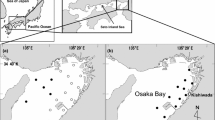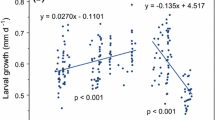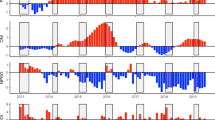Abstract
This study examined whether the potential early survival of sand lance in the Bisan Strait, central Seto Inland Sea, can be explained by variations in the growth rate and duration in the early life stages. Otolith microstructure analysis was conducted to examine the growth trajectories of specimens collected in six sampling years: 2011–2014, 2019, and 2020. There were significant differences in the growth rates of larvae and juveniles among sampling years, but such differences were likely attributable to variations in temperature in given seasons. Relative growth rates standardized by temperature were negatively correlated with the duration of the larval stage, suggesting that faster-growing individuals at given temperatures had a shorter larval stage. In each sampling year, there was a significant relationship between standardized hatch date and relative growth rate during the larval stage but not the juvenile stage. Within a given season, later-born larvae seemed to grow faster relative to the temperature experienced, and the higher percentages of the faster-growing larvae were likely associated with higher recruitment and recruitment per egg production. These findings suggest that the proportion of faster-growing sand lance larvae in a cohort at given temperatures explains the variation in potential early survival, but the higher temperatures in recent years may not necessarily contribute to improved early survival.









Similar content being viewed by others
Data Availability
The data supporting the findings of this study are available from the corresponding author, NA, upon reasonable request.
References
Akai N, Yoneda M (2021) Age-related variation in reproductive potential and influence on recruitment of western sand lance Ammodytes japonicus in the Seto Inland Sea, western Japan. J Sea Res 172:102036
Anderson JT (1988) A review of size dependent survival during pre-recruit stages of fishes in relation to recruitment. J Northwest Atl Fish Sci 8:55–66
Arnott SA, Ruxton GD (2002) Sandeel recruitment in the North Sea: Demographic, climatic and trophic effects. Mar Ecol Prog Ser 238:199–210
Beaugrand G, Brander KM, Lindley JA, Souissi S, Reid PC (2003) Plankton effect on cod recruitment in the North Sea. Nature 426:661–664
Blaxter JHS (1992) The effect of temperature on larval fishes. Neth J Zool 42:336–357
Buckley LJ, Caldarone EM, Lough RG (2004) Optimum temperature and food-limited growth of larval Atlantic cod (Gadus morhua) and haddock (Melanogrammus aeglefinus) on Georges Bank. Fish Oceanogr 13:134–140
Campana SE (1990) How reliable are growth back–calculations based on otolith? Can J Fish Aquat Sci 47:2219–2227
Campana SE (1996) Year-class strength and growth rate in young Atlantic cod Gadus morhua. Mar Ecol Prog Ser 135:21–26
Cushing D (1990) Plankton production and year- class strength in fish populations: an update of the match/mismatch hypothesis. Adv Mar Biol 26:249–293
Fortier L, Ponton D, Gilbert M (1995) The match/mismatch hypothesis and the feeding success of fish larvae in ice- covered southeastern Hudson Bay. Mar Ecol Prog Ser 120:11–27
Gurkan Z, Christensen A, Maar M, Moller EF, Madsen KS, Munk P, Mosegaard H (2013) Spatio-temporal dynamics of growth and survival of lesser sandeel early life-stages in the North Sea: predictions from a coupled individual based and hydrodynamic-biogeochemical model. Ecol Model 250:294–306
Hashiguchi S, Nishikawa T, Uozumi K, Furusawa K, Mori A, Imao K, Tanda M (2021) Causal factors of interannual decrease in stomach content index (SCI) of juvenile western sand lance Ammodytes japonicus in Harima-Nada, eastern Seto Inland Sea, Japan. Bull Jpn Soc Fish Oceanogr 85:24–32 (in Japanese with English abstract)
Hashimoto H (1984) Population structure of the sandeel around Japan. Bull Jap Soc Sc Fish 50:1357–1365
Hashimoto T, Yamamoto T, Tada K, Matsuda O, Nagasue T (1997) Primary production and physical structure of the Seto Inland Sea, Japan. Bull Mar Sci 35:109–114 (in Japanese, with English abstract)
Hiramatsu K (2001) VPA (Virtual Population Analysis). In: Tanaka S et al (eds) The Report of the Project of the Establishment of the Stock Assessment System—the Textbook of Stock Assessment Method. JFRCA, Kanagawa, pp 104–128 (in Japanese)
Hjort, J (1914) Fluctuations in the great fisheries of Northern Europe viewed in the light of biological research. Rapports et Proce’s-Verbaux des Re ´unions du Conseil International pour l’Exploration de la Mer 20: 1–228.
Houde ED (1989) Comparative growth, mortality, and energetics of marine fish larvae: temperature and implied latitudinal effects. Fish Bull 87:471–495
Houde ED (2008) Emerging from Hjort’s shadow. J Northwest Atl Fish Sci 41:53–70
Jensen H, Wright PJ, Munk P (2003) Vertical distribution of pre-settled sandeel (Ammodytes marinus) in the North Sea in relation to size and environmental variables. ICES J Mar Sci 60:1342–1351
Kamimura Y, Takahashi M, Yamashita N, Watanabe C, Kawabata A (2015) Larval and juvenile growth of chub mackerel Scomber japonicus in relation to recruitment in the western North Pacific. Fish Sci 81:505–513
Kusakabe T, Omi H, Saito M (2007) Growth in larval and juvenile Japanese sand lance Ammodytes personatus in eastern Seto Inland Sea determined by daily growth increments in otoliths. Bull Jpn Soc Fish Oceanogr 71:263–269 (in Japanese with English abstract)
Leggett WC, Frank KT (2008) Paradigms in fisheries oceanography. Oceanogr Mar Biol Annu Rev 46:331–363
Mitsuzawa A, Miyamoto H, Ueda H (2017) Feeding selectivity of early-stage fish larvae on the nauplii and eggs of different copepod species. Plankton Benthos Res 12:115–122
Nagoshi M, Sano M (1979) Population studies of sand eel, Ammodytes personatus, in Ise Bay I. Growth and its relation to population density. Japan J Ecol 29:1–10
Nakata K (2001) Relationship between zooplankton and fish -Zooplankton as a factor in fish recruitment variability. Gekkan Kaiyo (extra Issue) 27:238–243 (in Japanese)
Nishikawa T, Nakamura Y, Okamoto S, Ueda H (2020) Interannual decrease in condition factor of the western sand lance Ammodytes japonicus in Japan in the last decade: Evidence for food-limited decline of the catch. Fish Oceanogr 29:52–55
Nishikawa T, Watanabe T, Shiotani T, Izumi S, Furusawa K, Tadokoro K (2023) Seasonal copepod dynamics and biomass in Harimna-Nada, eastern Seto Inland Sea, Japan. Fish Sci 89:343–356
Omi H, Kusakabe T, Saito M (2006) Validation of the daily deposition of otolith increments in the Japanese sand lance larvae and juveniles. Bull Osaka Pref Fish Exp Stat 16:1–5 (in Japanese)
Ottersen G, Loeng H (2000) Covariability in early growth and year-class strength of Barents Sea cod, haddock, and herring: the environmental link. ICES J Mar Sci 57:339–348
Peck MA, Huebert KB, Llopiz JK (2012) Intrinsic and extrinsic factors driving match- mismatch dynamics during the early life his- tory of marine fishes. Adv Ecol Res 47:77–302
Pope JG (1972) An investigation of the accuracy of virtual population analysis using cohort analysis. Bull Int Comm Northwest Atl Fish Res 9:65–74
Potter DC, Lough RG (1987) Vertical distribution and sampling variability of larval and juvenile sand land (Ammodytes sp.) on Nanutcket Shoals and George Bank. J Northweast Atl Fish Sci 7:107–116
R Core Team (2023) R: a language and environment for statistical computing. R Foundation for Statistical Computing. https://www.R-proje ct.org/
Régnier T, Gibb FM, Wright PJ (2017) Importance of trophic mismatch in a winter- hatching species: evidence from lesser sandeel. Mar Ecol Prog Ser 567:185–197
Richards SW, Kendall JAW (1973) Distribution of sand lance, Ammodytes sp., larvae on the continental shelf from Cape Cod to Cape Hatteras from RV Dolphin surveys in 1966. Fish Bull 71:371–386
Robert D, Castnguay M, Fortier L (2007) Early growth and recruitment in Atlantic mackerel Scomber scombrus: discriminating the effects of fast growth and selection for fast growth. Mar Ecol Prog Ser 337:209–219
Shelley CE, Johnson DW (2022) Larval fish in a warming ocean: a bioenergetic study of temperature-dependent growth and assimilation efficiency. Mar Ecol Prog Ser 691:97–114
Takahashi M, Kono N (2021) Stock assessment and evaluation for eastern Seto Inland Sea western sand lance stocks (fiscal year: 2020). Marine fisheries stock assessment and evaluation for Japanese waters (fiscal year 2020/2021). Fisheries Agency and Fisheries Research Agency of Japan, Tokyo (in Japanese)
Takeoka H (1985) Density stratification in the Seto Inland Sea. Sea and Sky 60:145–152 (in Japanese, with English abstract)
Tanda M, Okamoto S (1992) An ecological view on the variations in the sand lance population in the eastern Seto Inland Sea. Bull Jpn Soc Fish Oceanogr 56:201–205 (in Japanese)
Tomiyama M, Komatsu T (2006) Effects of temperature on growth and recruitment during early life history of the Japanese sandeel in Ise Bay. Bull Jpn Soc Fish Oceanogr 70:114–121 (in Japanese with English abstract)
Tsukamoto Y, Yamada H, Zenitani H (2002) Microincrements of otoliths of the Japanese sand lance Ammodytes personatus during early life stages. Fish Sci 68:1158–1160
Tsumoto K, Yamada H (1997) Development of eggs, larvae and juveniles of Japanese sand lance Ammodytes personatus in Ise Bay; report of the Basic Investigation on Development of Productivity Model in Fishing Ground in Ise Bay and Mikawa Bay. National Res Inst Fish Sci, Yokohama, pp 36–38 (in Japanese)
Uozumi K, Nishikawa T (2023) Interannual decrease in egg production index of western sand lance Ammodytes japonicus population in Harima-Nada, eastern Seto Inland Sea, Japan. Nippon Suisan Gakkaishi 89:15–21(in Japanese, with English abstract)
Uye S, Kuwata H, Endo T (1987) Standing stocks and production rates of phytoplankton and planktonic copepods in the Inland Sea of Japan. J Oceanogr Soc Jpn 42:421–434
van Deurs M, van Hal R, Tomczak MT, Jónasdóttir SH, Dolmer P (2009) Recruitment of lesser sandeel Ammodytes marinus in relation to density dependence and zooplankton composition. Mar Ecol Prog Ser 381:249–258
Wright PJ, Bailey MC (1996) Timing of hatching in Ammodytes marinus from Shetland waters and its significance to early growth and survivorship. Mar Biol 126:143–152
Yamada H (2011) Studies on the mechanisms of recruitment determination of Japanese sand lance Ammodytes personatus in Ise Bay. Bull Mie Pref Fish Res 19:1–7 (in Japanese)
Yamashita Y, Kitagawa D, Aoyama T (1985) Diel vertical migration and feeding rhythm of the larvae of the Japanese sand-eel Ammodytes personatus. Nippon Suisan Gakkaishi 51:1–5
Yoneda M, Fujita T, Yamamoto M, Tadokoro K, Okazaki Y, Nakamura M, Takahashi M, Kono N, Matsubara T, Abo K, **nyu G, Yoshie N (2022) Bottom-up processes drive reproductive success of Japanese anchovy in an oligotrophic sea: a case study in the central Seto Inland Sea. Japan Prog Oceanogr 206:102860
Acknowledgements
This work was partly supported by the Fisheries Agency, Fisheries Research Agency of Japan and by Grants-in-Aid for Challenging Research (Pioneering) (KAKENHI No. 19H05540) and Scientific Research (B) (KAKENHI No. 22H02421) from the Japan Society for the Promotion of Science. Some of the samples used in this study were collected in collaboration with the Kagawa Prefectural Fisheries Experimental Station as well as Japan Fisheries Research and Education; we especially thank Mr. Kei Takasago and Dr. Masanori Takahashi for the help with arrangement in the preparation of otolith analysis. We also thank the editor and the two anonymous reviewers for helpful comments on the manuscript.
Author information
Authors and Affiliations
Corresponding author
Ethics declarations
Conflict of interest
The authors declare that they have no known competing financial interests or personal relationships that could have appeared to influence the work reported in this paper.
Additional information
Publisher's Note
Springer Nature remains neutral with regard to jurisdictional claims in published maps and institutional affiliations.
Supplementary Information
Below is the link to the electronic supplementary material.
Rights and permissions
Springer Nature or its licensor (e.g. a society or other partner) holds exclusive rights to this article under a publishing agreement with the author(s) or other rightsholder(s); author self-archiving of the accepted manuscript version of this article is solely governed by the terms of such publishing agreement and applicable law.
About this article
Cite this article
Akai, N., Saito, M. & Yoneda, M. Inter-annual variation in the relationship between early growth rate and potential survival of the western sand lance Ammodytes japonicus in the Seto Inland Sea in western Japan. Fish Sci 90, 591–605 (2024). https://doi.org/10.1007/s12562-024-01785-y
Received:
Accepted:
Published:
Issue Date:
DOI: https://doi.org/10.1007/s12562-024-01785-y




